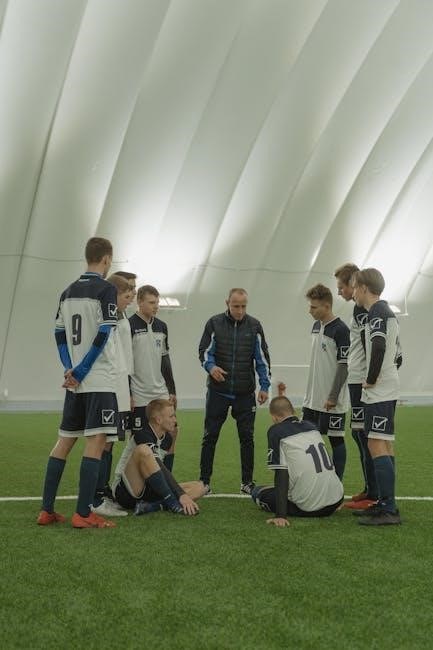Youth football drills are essential for skill development, focusing on structured training and age-specific plans to enhance performance safely. Downloadable resources like the ’50 drills for youth players.pdf’ offer practical guidance.
Importance of Structured Drills in Youth Football Development
Structured drills are vital for youth football development, fostering skill mastery, teamwork, and confidence. They create a safe, focused environment for young athletes to improve fundamentals like tackling, passing, and footwork. By breaking skills into manageable parts, drills help players build a strong foundation. Age-specific plans ensure exercises align with developmental stages, preventing injuries and enhancing engagement. Consistent practice through drills improves technique, reaction time, and game readiness. Coaches can tailor drills to address specific needs, making them adaptable and effective for all skill levels. This organized approach not only boosts performance but also instills discipline and a love for the sport.
Warm-Up and Fundamental Drills
Warm-up and fundamental drills are crucial for preparing young players, improving flexibility, and preventing injuries. These exercises focus on essential skills like dynamic stretching and agility.
Dynamic Stretching for Injury Prevention
Dynamic stretching is a vital component of youth football warm-ups, designed to prevent injuries by increasing flexibility and blood flow. Players perform movements like arm circles, leg swings, and high knees, which mimic game actions. These exercises prepare muscles for physical activity, reducing the risk of strains and pulls. Coaches should emphasize proper form to maximize effectiveness. Incorporating dynamic stretches into daily routines helps build a foundation for safer, more robust play. This approach ensures young athletes are adequately prepared for the demands of the sport while minimizing injury risks. Consistency is key to long-term player development and overall team performance.
High Knees and Foot Speed Drills
High knees and foot speed drills are fundamental for improving agility and acceleration in youth football. These exercises focus on quick movements, such as rapid foot strikes and explosive sprints, enhancing a player’s ability to change direction swiftly. Drills like the 3-on-1 and 3-on-2 simulations challenge athletes to react to blockers while maintaining speed. Proper technique, such as keeping knees high and staying low, is emphasized to maximize efficiency. These drills not only boost foot speed but also build endurance and coordination, essential for outperforming opponents on the field. Consistent practice ensures players develop the agility needed for advanced game situations.

Offensive Drills for Youth Football
Offensive drills focus on refining ball control, passing accuracy, and handoff techniques. Resources like the ’50 drills for youth players.pdf’ provide structured exercises for skill mastery and game readiness.
Ball Control Drills: Figure-Eight and Cone Weave
Ball control drills like the Figure-Eight and Cone Weave are fundamental for developing dexterity and precision in youth football. These exercises require players to navigate the ball through cones arranged in a figure-eight pattern or weave through them, enhancing agility and focus. By incorporating these drills, young athletes improve their ability to maintain possession under pressure, a critical skill for offensive play. Coaches can find detailed instructions and variations of these drills in resources such as the ’50 drills for youth players.pdf,’ ensuring effective skill development in a structured and engaging manner.
Passing Accuracy and Technique
Passing accuracy and technique are vital skills for youth football players, emphasizing proper grip, foot placement, and follow-through. Drills like the GTKY (Give, Take, You Keep) circle passing game encourage engagement while improving precision. Players start with short, controlled passes, progressively increasing distance and speed. The 2v2 football tennis tournament adds a competitive edge, rewarding accuracy and teamwork. Consistent practice with these structured drills helps build confidence and consistency in passing, essential for effective offensive play. These exercises are detailed in resources like the ’50 drills for youth players.pdf,’ providing coaches with actionable strategies to refine passing skills.
Handoff and Running Back Drills
Handoff and running back drills focus on developing ball control, agility, and decision-making. A balanced 2-point stance is emphasized, with feet slightly wider than shoulders and knees bent. Players practice securing handoffs and exploding forward, avoiding false steps. The ‘Hustle Drill’ improves pursuit techniques, while the ‘3-on-1 Drill with Cones’ teaches defenders to react and pursue the ball carrier. These drills build confidence and reflexes, ensuring running backs can navigate blockers effectively. Structured repetitions with cones and pads refine footwork and vision, preparing players for game situations. Resources like the ’50 drills for youth players.pdf’ provide detailed guidance for coaches to enhance these skills safely and efficiently.
Defensive Drills for Youth Football
Defensive drills build agility, reaction, and tackling skills. Techniques like the ‘Chute Drill’ and ‘Angle Tackle’ enhance tackling form and safety. Resources such as ’50 drills for youth players.pdf’ provide structured exercises to improve pursuit and footwork, essential for young defenders.
Tackling Drills: Chute and Angle Tackle
The Chute Drill is a fundamental tackling exercise where players practice proper form and technique. Using a tackling chute, athletes focus on keeping their heads up, shoulders squared, and driving through the bag or pad. This drill emphasizes explosive power and safe tackling mechanics. The Angle Tackle Drill teaches defenders to approach ball carriers at different angles, promoting effective wrap-up techniques and balance. These drills are crucial for developing confident and safe tacklers, ensuring young players master the basics while minimizing injury risks. Both drills are widely recommended in youth football training resources, such as the ’50 drills for youth players.pdf’ guide.
Defensive Footwork: Ladder and Mirror Drills
Ladder drills are excellent for enhancing agility and quick footwork, essential for defensive players; Players perform high knees, lateral shuffles, and carioca drills through the ladder to improve speed and coordination. Mirror drills focus on reaction and balance, where defenders mimic an opponent’s movements, staying low and maintaining proper stance. These drills are fundamental for building a strong defensive foundation. They are widely recommended in youth football training resources, such as the ’50 drills for youth players.pdf’ guide, to build defensive skills safely and efficiently, ensuring young athletes develop the necessary footwork for game situations.
Special Teams Drills
Special teams drills focus on punting, kicking, and field goal attempts. These exercises help players master techniques for scoring and field position. Essential for game readiness.
Punting and Kicking Drills
Punting and kicking drills are vital for special teams success. These exercises focus on accuracy, power, and technique. Start with short-distance kicks to build consistency and gradually increase difficulty. Use drills like the Punting Accuracy Drill, where players aim for specific targets, and the Kicking Field Goal Challenge, simulating game scenarios. Emphasize proper footwork, ball placement, and follow-through. Encourage players to practice under pressure to improve mental toughness. Incorporate safety measures, such as proper tackling and blocking techniques, to prevent injuries. These drills help develop skilled special teams players capable of making game-changing plays.

Age-Specific Drills
Age-specific drills cater to varying developmental stages, ensuring safety and skill progression. They are tailored for players aged 5-8, 9-12, and 13-15, focusing on fun, engagement, and advanced techniques.
Drills for Ages 5-8: Fun and Skill Development
For ages 5-8, drills emphasize fun and foundational skills. Activities like GTKY (circle passing) and 2v2 football tennis engage players while developing coordination and teamwork. These drills use games to introduce basic football concepts, ensuring young athletes stay motivated and build a love for the sport. The focus is on simplicity and enjoyment, allowing children to explore movement and ball control in a supportive environment. Structured yet playful, these exercises lay the groundwork for future skill development while keeping the atmosphere positive and encouraging.
Drills for Ages 9-12: Building Advanced Skills
For ages 9-12, drills focus on advancing skills through structured, engaging exercises. The 3-on-1 and 3-on-2 drills enhance defensive reactions and pursuit techniques, while cone drills improve agility and speed. Players refine ball control with figure-eight and weave exercises, building confidence in game-like scenarios. Passing accuracy and handoff drills are emphasized to prepare for more competitive play. These activities challenge young athletes to master fundamental techniques while introducing strategic elements; The drills are designed to foster teamwork, discipline, and a deeper understanding of the game, ensuring a smooth transition to higher-level football as they grow.
Combining Skills in Game Situations
Drills like 3-on-2 and 3-on-1 enhance game readiness by simulating real scenarios, teaching players to apply multiple skills cohesively in competitive situations, improving decision-making and teamwork under pressure.
3-on-2 and 3-on-1 Drills for Game Readiness
The 3-on-2 and 3-on-1 drills simulate real-game scenarios, focusing on defensive reactions and offensive strategies. These drills teach players to deliver blows, separate from blockers, and pursue the ball carrier effectively. By incorporating cones, they mimic game situations, enhancing agility and decision-making. Defensive players learn to navigate through blockers, while offensive players practice evasive maneuvers. These drills are crucial for developing tactical awareness and teamwork, ensuring players are prepared for the challenges of actual games. They are structured to maximize engagement and skill development, making them indispensable in youth football practice plans. Proper execution ensures safety and effectiveness.

Safety and Concussion Protocols
Safety is paramount in youth football. Proper tackling techniques, equipment checks, and concussion education ensure player well-being. Coaches must enforce safe practices and monitor for potential injuries.
Safe Tackling Techniques and Drill Modifications
Safe tackling techniques focus on reducing injury risks. Players are taught to lead with their shoulders, keep their heads up, and wrap securely. Drills like the chute and angle tackle emphasize proper form. Modifications, such as removing full contact in certain exercises, help adapt practices to younger athletes’ needs. Coaches must ensure equipment fits correctly and supervise drills closely to enforce safety protocols. These adjustments promote a safer environment while maintaining skill development.

Sample Practice Plan
A structured session includes warm-ups, skill drills, and game-ready exercises. Coaches can adjust drills by age and skill level, ensuring safety and maximizing engagement.
Structured Session for Maximum Engagement and Skill Development
A well-organized practice plan is crucial for youth football. Begin with dynamic warm-ups to prevent injuries and boost focus. Incorporate age-specific drills, such as the 3-on-2 and 3-on-1 drills, to simulate game scenarios and improve decision-making. Use cones and ladders for footwork and agility training. End with small-sided games to apply skills in real-time. Ensure each drill transitions smoothly to maintain player engagement and maximize skill development. Coaches should adapt activities based on the team’s age and skill level, promoting a safe and effective learning environment. This structured approach fosters both physical and tactical growth in young athletes.

